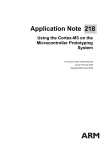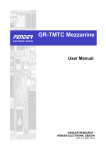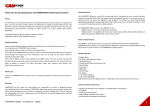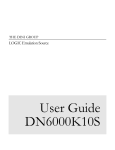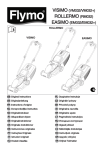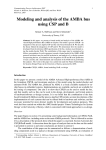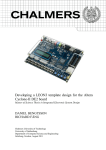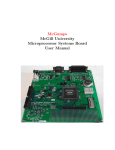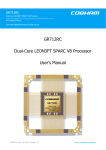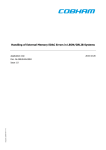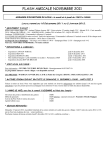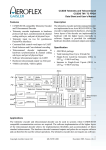Download Packet Telecommand Decoder with AMBA AHB Interface
Transcript
Packet Telecommand Decoder with AMBA AHB Interface (PDEC3AMBA) Data Sheet SCTMTC-002-01 Version 0 October 2003 Prepared by Sandi Habinc Stora Nygatan 13 411 08 Göteborg Sweden tel +46 31 802405 fax +46 31 802407 www.gaisler.com SCTMTC-002-01 1 INTRODUCTION 1.1 Scope 2 This document describes the Packet Telecommand Decoder with AMBA AHB Interface (PDEC3AMBA) synthesizable VHDL model. The objective is to describe the model at a level of detail allowing its integration into an overall system. It is not the objective to describe the model to a level of detail allowing modifications or usage of individual modules in the model hierarchy. The PDEC3AMBA model has been developed within the Highly Integrated Control and Data System (HICDS) activity. It is based on the Packet Telecommand Decoder (PDEC3) module, the External CPDU Interface Module (ExtCpduIf), the CPDM Selector Module (CSEL) and the Command Pulse Distribution Module (CPDM), all developed by Saab Ericsson Space and used in the Single Chip Telemetry and Telecommand (SCTMTC) ASIC developed in the HICDS activity. 1.2 Introduction The purpose of the Packet Telecommand Decoder with AMBA AHB Interface (PDEC3AMBA) synthesizable VHDL model is to provide the user with a single module implementing CCSDS/ ESA compatible telecommand decoder and command pulse distribution unit with an AMBA Advanced High-performance Bus (AHB) interface. 1.3 How to read this document Not to duplicate information already available elsewhere, this document makes use of extensive references to the SCTMTC ASIC User’s Manual (AD2) in which the various module functions are described in detail. Only newly introduced information or deviations are reported in this document. 1.4 Disclaimer The responsibility of Gaisler Research for the Packet Telecommand Decoder with AMBA AHB Interface (PDEC3AMBA) synthesizable VHDL model is limited to the AMBA AHB adaptation. The responsibility for the embedded modules remains with Saab Ericsson Space. 1.5 Constraints Although the embedded modules can be configured according to user needs, the configuration of the PDEC3AMBA model has been constrained to the module configurations used in the SCTMTC ASIC. In this way the basic telecommand decoder functionality of the module VHDL models as used in PDEC3AMBA has already been validated in the HICDS activity, not requiring any further validation. SCTMTC-002-01 3 1.6 Applicable documents AD1 AMBATM Specification, Rev 2.0, ARM IHI 0011A, 13 May 1999, Issue A, first release, ARM Limited SCTMTC ASIC User's Manual, P-ASIC-NOT-00122-SE, Issue 6, September 2003, Saab Ericsson Space, Sweden AD2 1.7 Applicable VHDL source code AD3 AD5 SCTMTC ASIC synthesizable VHDL Model, delivered on 9 September 2003, Saab Ericsson Space, sctmtc.tar.gz Packet Telecommand Decoder with AMBA AHB Interface (PDEC3AMBA) synthesizable VHDL model, version 0.1, Nov. 2003, pdec3amba.vhd AMBA synthesizable VHDL package, version 0.5, February 2002, amba.vhd 1.8 Reference documents RD1 RD2 RD3 ESA VHDL Modelling Guidelines, ASIC/001, Issue 1, September 1994 IEEE Standard VHDL Language Reference Manual, IEEE Std 1076-1993 IEEE Standard Multivalue Logic System for VHDL Model Interoperability (Std_Logic_1164), IEEE Std 1164-1993 IEEE Standards Interpretations: IEEE Standard VHDL Language Reference Manual, IEEE Std 1076/INT-1991 AD4 RD4 1.9 Related documents The applicable and reference documents related to the embedded modules are described in sections 3.1 and 3.2 in AD2, respectively. 1.10 AHB AMBA ESA HICDS PW VHDL VHSIC Acronyms and abbreviations Advanced High-performance Bus (AMBA interface) Advanced Microcontroller Bus Architecture TM European Space Agency Highly Integrated Control and Data System PacketWire VHSIC Hardware Description Language Very High Speed Integrated Circuits SCTMTC-002-01 4 2 CONVENTIONS 2.1 Advanced Microcontroller Bus Architecture Convention according to the Advanced Microcontroller Bus Architecture (AMBA) Specification, AD1, applying to the AHB and APB interfaces: • Signal and port names are in upper case, except for the following: • A lower case 'n' in the name indicates that the signal or port is active low. • Constant names are in upper case. • The least significant bit of an array is located to the right, carrying index number zero. AMBA n-bit field most significant n-1 Table 1: 2.2 least significant n-2 down to 1 0 AMBA n-bit field definition Consultative Committee for Space Data Systems Convention according to the Consultative Committee for Space Data Systems (CCSDS) recommendations, applying to all relevant structures: • The most significant bit of an array is located to the left, carrying index number zero, and is transmitted first. • An octet comprises eight bits. General convention, applying to signals, ports and interfaces: • Signal or port names are in mixed case. • An upper case '_N' suffix in the name indicates that the signal or port is active low. CCSDS n-bit field most significant 0 Table 2: 2.3 least significant 1 to n-2 n-1 CCSDS n-bit field definition Data structures Data structures specific to the embedded modules are described in sections 4.9.3 and 4.9.6 in AD2. 2.4 Waveform formats Waveform formats specific to the embedded modules are described in sections 7.3.1.2, 7.3.2, 7.4.1 and 7.6.2 in AD2. SCTMTC-002-01 3 5 OVERVIEW The Packet Telecommand Decoder with AMBA AHB Interface (PDEC3AMBA) VHDL model comprises the following modules: • Packet Telecommand Decoder (PDEC3) Module • External CPDU Interface Module (ExtCpduIf) • CPDM Selector Module (CSEL) • Command Pulse Distribution Module (CPDM) The purpose of the PDEC3AMBA model is to provide AMBA AHB interface to the embedded modules, converting between the proprietary internal PI-bus and the AMBA AHB specification. A simple block diagram of the model is shown in figure 1. AMBA AHB PDEC3AMBA PDEC3 Transponder I/F PI2AHB Coding Layer PI2AHB Transfer Layer Configuration I/F PI2AHB Authentication Layer PI2AHB Segmentation Layer MAP I/F CLCW I/F Telemetry Reporting AHB2PI MAP 0 TC request MAP 6 TcOnly PI2AHB CPDU I/F CPDM PM request RM request External CPDU I/F PI2AHB Figure 1: CSEL CPDM request CSEL Status I/F External CPDU I/F PDEC3AMBA block diagram Note that the External CPDU Interface is acting as the Reconfiguration Module in the PDEC3AMBA VHDL model. It is thus not possible to connect the External CPDU Interface to the Telecommand input of the CSEL module. More detailed information can be found in section 5.4.1.5.4 in AD2. All CSEL external ports are thus only related to the External CPDU Interface. SCTMTC-002-01 4 6 DESCRIPTION Not to duplicate information already available, this document makes use of extensive references to the SCTMTC ASIC User’s Manual (AD2) in which various module functions are described in detail. Only newly introduced information or deviations are reported herein. 4.1 Functionality The functionality of the embedded modules is described in sections 5.4.3, 5.4.4, 5.4.5, and 5.4.6 in AD2. 4.2 Software interface The software interface of the embedded modules is described in sections 6.3, 6.4, 6.5, and 6.6 in AD2. The register definition summary related to the embedded modules is described in sections 6.10, 6.10.3, 6.10.4, 6.10.5, and 6.10.6 in AD2. The memory usage and mapping of the embedded modules is described in section 6.11.3 in AD2. The overall memory map for the embedded modules is described in section 5.4.2.2 in AD2. 4.3 Hardware interface (external) The hardware interface of the embedded modules is described in sections 7.3, 7.4, 7.5, and 7.6 in AD2. 4.4 AMBA AHB slave interface (internal) All registers of the embedded modules are accesses via a single AMBA AHB slave interface of the PDEC3AMBA VHDL model. The AMBA AHB slave interface has been reduced in functionality to support only what is required. The following features are constrained: • only supports HSIZE = HSIZE_WORD, HRESP_ERROR generated otherwise • only supports HMASTLOCK = 0b, HRESP_ERROR generated otherwise • no HBURST decoding, bursts are thus supported • no HPROT decoding • neither HRESP_HSPLIT nor No HRESP_HRETRY generated • only big-endianness is supported • HRESP_ERROR is generated on: • address outside decoded register areas • error response from module • ready response not generated from module within 16 HCLK cycles. • HADDR(1 downto 0) not checked • specific address decoding for four register modules: • HADDR(15 downto 10) = module select • HADDR(9 downto 2) = module register address • complete address decoding is not performed, for compatibility with AD2 the register space should be decoded accordingly by an external AMBA AHB arbiter / decoder • access to protected registers can only be done when the HSUPERUSER port is asserted SCTMTC-002-01 4.5 7 AMBA AHB master interface (internal) Each AMBA AHB master interface has been reduced in functionality to support only what is required for the PDEC3AMBA model. One AMBA AHB master interface is provided for each PI-bus DMA channel. The following AMBA AHB master interface features are constrained: • only generates HSIZE = HSIZE_BYTE, HSIZE_HALFWORD and HSIZE_WORD • only generates HLOCK = 0b • only generates HPROT = 0000b • only generates HBURST = HBURST_SINGLE • never generates HTRANS = HTRANS_BUSY • generates the following responses to the embedded modules: • HRESP = HRESP_OKAY, ends access with ready • HRESP = HRESP_ERROR, ends access with error • HRESP = HRESP_RETRY, access is rescheduled till ready or error • HRESP = HRESP_SPLIT, access is rescheduled till ready or error • only big-endianness is supported, but: • a byte is always mapped on data bits (7 downto 0) on PI-bus side, and • a halfword is always mapped on data bits (15 downto 0) on PI-bus side • only two outstanding acknowledgments allowed on PI-bus side • • • • PI-bus lock is not supported PI-bus bursts are not supported PI-bus flush is unused PI-bus page is not supported. Note that the performance of the interface is limited due to the fact that the PI-bus interface requires that input signals are driven directly from a flip-flop at the source. Throughput: Latency: Pipeline: Sustained transfer rate is one access in 2 HCLK periods at zero AMB AHB waitstates. From PI-bus DmaReq asserted to PI-bus DmaRdy sampled: 4 to 5 HCLK periods at zero AMB AHB waitstates. Only one PI-bus access is handled at a time, to provide for automatic error handling and retry. The PDEC3AMBA module can act as a default AHB master generating idle accesses when required. It only implements a single word access at a time, without bursts, to reduce complexity for retry and split handling, and not requiring the 1024 byte boundary imposed by the AMBA specification on burst transfers to be taken into account. SCTMTC-002-01 4.6 8 Design aspects The PDEC3AMBA model is a fully synchronous design based on a single system clock strategy. Registers in the model are reset asynchronously or synchronously. The reset input can be asserted asynchronously, but requires synchronous de-assertion to avoid any recovery time violations. The width of the asserted pulse of the HRESETn input signal should be at least one HCLK clock period. The priority, latency and throughput requirements of the six AMBA AHB master interfaces of the PDEC3AMBA model are listed in table 3. Priority Interface name Latency and Throughput 1 = highest 2 AHBMSibWr AHBMSlrb one access for every 16 telecommand input bits one access for every 16 MAP interface output bits 3 4 5 6 = lowest AHBMAub AHBMCpdu AHBMExtCpdu AHBMSibRd 368+1024 accesses for every 192 telecommand input bits two accesses for each pulse command duration one access for every 16 input bits eight accesses for every 192 telecommand input bits Table 3: Priority and latency requirements The interrupt signals AHBSIrq_PDEC3, AHBSIrq_CSEL and AHBSIrq_CPDM are asserted for one HCLK clock period when an interrupt occurs. SCTMTC-002-01 5 9 INTERFACES The Packet Telecommand Decoder with AMBA AHB Interface (PDEC3AMBA) VHDL model interfaces are listed in table 4 and described in the subsequent sections. Name Type Mode Description Remark System interface HRESETn Std_ULogic in Asynchronous reset HCLK Std_ULogic in System clock HSUPERUSER Std_ULogic in Super-user enable AMBA AHB Slave interface AHBSIn AHB_Slv_In_Type in AMBA AHB slave input AHBSOut AHB_Slv_Out_Type out AMBA AHB slave output AHBSIrq_PDEC3 Std_ULogic out Pending interrupt PDEC3 AHBSIrq_CSEL Std_ULogic out Pending interrupt CSEL AHBSIrq_CPDM Std_ULogic out Pending interrupt CPDM AMBA AHB Master interface - Serial Input block AHBMSibWrIn AHB_Mst_In_Type in AMBA AHB master input PDEC3 AHBSMibWrOut AHB_Mst_Out_Type out AMBA AHB master output AMBA AHB Master interface - Segmentation Layer and Router block AHBMSlrbIn AHB_Mst_In_Type in AMBA AHB master input PDEC3 AHBMSlrbOut AHB_Mst_Out_Type out AMBA AHB master output AMBA AHB Master interface- Authentication block AHBMAubIn AHB_Mst_In_Type in AMBA AHB master input PDEC3 AHBMAubOut AHB_Mst_Out_Type out AMBA AHB master output in AMBA AHB master input ExtCpduIf out AMBA AHB master output AMBA AHB Master interface - External CPDU Interface AHBMExtCpduIn AHB_Mst_In_Type AHBMExtCpduOut AHB_Mst_Out_Type AMBA AHB Master interface - Command Pulse Distribution Unit AHBMCpduIn AHB_Mst_In_Type in AMBA AHB master input CPDM AHBMCpduOut AHB_Mst_Out_Type out AMBA AHB master output AMBA AHB Master interface - Serial Input block AHBMSibRdIn AHB_Mst_In_Type in AMBA AHB master input PDEC3 AHBMSibRdOut AHB_Mst_Out_Type out AMBA AHB master output Table 4: PDEC3AMBA interfaces SCTMTC-002-01 10 Name Type Mode Description Packet Telecommand Decoder (PDEC3) PdecTcAct Std_ULogic_Vector(5 downto 0) in Channel Active PdecTcClk Std_ULogic_Vector(5 downto 0) in Channel clock PdecTcIn Std_ULogic_Vector(5 downto 0) in Channel data PdecRfAv_N Std_ULogic_Vector(3 downto 0) in RF Available PdecTcPrior Std_ULogic in Priority mode PdecTcDyn Std_ULogic in Dynamic mode PdecAuEnable Std_ULogic in AU enabled PdecMapAdt Std_ULogic out MAP aborted PdecMapClk Std_ULogic out MAP clock PdecMapData Std_ULogic out MAP data PdecMapDsrG Std_ULogic out Sender ready PdecMapDtrG Std_ULogic in Receiver ready PdecMapDsr Std_ULogic_Vector(5 downto 1) out Sender ready PdecMapDtr Std_ULogic_Vector(5 downto 1) in Receiver ready PdecMapGenA Std_ULogic_Vector(5 downto 0) out Address PdecClcwClk Std_ULogic_Vector(1 downto 0) in CLCW clock PdecClcwSamp Std_ULogic_Vector(1 downto 0) in CLCW control PdecClcwD Std_ULogic_Vector(1 downto 0) out CLCW data PdecMapSwitch Std_ULogic in MAP switch External Command Pulse Distribution Unit Interface (ExtCPDUIF) ExtCpduIfClk Std_ULogic in Clock ExtCpduIfValid Std_ULogic in Delimiter ExtCpduIfRdy Std_ULogic out Ready for octet ExtCpduIfData Std_ULogic in Data ExtCpduIfAbort Std_ULogic in Abort ExtCpduIfEn Std_ULogic in Enable interface Command Pulse Distribution Selection (CSEL) CselRmOn Std_ULogic in Toggle mode CselStatusIn Std_ULogic_Vector(2 downto 0) in Status in CselStatusOut Std_ULogic_Vector(2 downto 0) out Status out Command Pulse Distribution Manager (CPDM) CpdmStrb Std_ULogic out Strobe CpdmArm_N Std_ULogic out Arm CpdmSer Std_ULogic out Data CpdmClk Std_ULogic out Clock CpdmClkAlive Std_ULogic in Clock alive CpdmClkToggle Std_ULogic out Clock toggle Table 4: PDEC3AMBA interfaces Remark SCTMTC-002-01 11 5.1 System interface 5.1.1 HRESETn: Synchronised reset: Std_ULogic (I) This active low input port asynchronously resets the model. The port is assumed to be deasserted synchronously with the HCLK system clock. 5.1.2 HCLK: System clock: Std_ULogic (I) This input is the system clock of the model. Most registers are clocked on the rising HCLK edge. 5.1.3 HSUPERUSER: Super User Enable: Std_ULogic (I) This input port enables super user access to protected registers when enable. These registers are listed as accessible only during configuration in AD2. 5.2 Packet Telecommand Decoder (PDEC3) Refer to sections 7.3 and 7.10.3 in AD2 for details regarding the external ports. All outputs are clocked out on the rising HCLK edge. All inputs are sampled on the rising HCLK edge. 5.3 External Command Pulse Distribution Unit Interface (ExtCPDUIF) Refer to sections 7.4 and 7.10.4 in AD2 for details regarding the external ports. All outputs are clocked out on the rising HCLK edge. All inputs are sampled on the rising HCLK edge. 5.4 Command Pulse Distribution Selection (CSEL) Refer to sections 7.5 and 7.10.5 in AD2 for details regarding the external ports. All outputs are clocked out on the rising HCLK edge. All inputs are sampled on the rising HCLK edge. 5.5 Command Pulse Distribution Manager (CPDM) Refer to sections 7.6 and 7.10.6 in AD2 for details regarding the external ports. All outputs are clocked out on the rising HCLK edge. All inputs are sampled on the rising HCLK edge. SCTMTC-002-01 5.6 12 AMBA AHB slave interface For detailed information on the records used for the AMBA AHB interface see AD1 and AD5. 5.6.1 AHBSIn: Interface input: AHB_Slv_In_Type (I) This port record is the general AHB slave interface input. 5.6.1.1 HSEL: Slave select: Std_ULogic (I) This port indicates that the AHB slave interface is selected. The input is sampled on the rising HCLK edge. 5.6.1.2 HADDR: Address bus: Std_Logic_Vector(HAMAX-1 downto 0) (I) This port carries the address of the access to the AHB slave interface. The input is sampled on the rising HCLK edge. HAMAX is defined in the AMBA VHDL package, AD5. HAMAX is assumed to be the default 32. 5.6.1.3 HWRITE: Read / Write: Std_ULogic (I) This port indicates whether it is a read or a write access to the AHB slave interface. The input is sampled on the rising HCLK edge. 5.6.1.4 HTRANS: Transfer type: Std_Logic_Vector(1 downto 0) (I) This port indicates the access type to the AHB slave interface. Sampled on rising HCLK edge. 5.6.1.5 HSIZE: Transfer size: Std_Logic_Vector(2 downto 0) (I) This port indicates the size of the access to the AHB slave interface. The input is sampled on the rising HCLK edge. 5.6.1.6 HBURST: Burst type: Std_Logic_Vector(2 downto 0) (I) This port indicates the type of burst of the access to the AHB slave interface. The input is sampled on the rising HCLK edge. 5.6.1.7 HWDATA: Write data bus: Std_Logic_Vector(HDMAX-1 downto 0) (I) This port carries the data of the write transfer to the AHB slave interface. The input is sampled on the rising HCLK edge. HDMAX is defined in the AMBA VHDL package, AD5. HDMAX is assumed to be the default 32. 5.6.1.8 HPROT: Protection control: Std_Logic_Vector(3 downto 0) (I) This port indicates the protection type of the access to the AHB slave interface. The input is sampled on the rising HCLK edge. 5.6.1.9 HREADY: Transfer Done: Std_ULogic (I) This port indicates that the transfer is completed to the AHB slave interface. The input is sampled on the rising HCLK edge. SCTMTC-002-01 13 5.6.1.10 HMASTER: Current master: Std_ULogic (I) This port indicates which master is performing the current transfer to the AHB slave interface. The input is sampled on the rising HCLK edge. 5.6.1.11 HMASTLOCK: Lock request: Std_ULogic (I) This port indicates whether the transfer to the AHB slave interface is a locked access. The input is sampled on the rising HCLK edge. 5.6.2 AHBSOut Interface output: AHB_Slv_Out_Type (O) This port record is the general AHB slave interface output. 5.6.2.1 HREADY: Transfer done: Std_ULogic (O) This port indicates that an access is completed by the AHB slave. The output is clocked out on the rising HCLK edge. 5.6.2.2 HRESP: Response type: Std_Logic_Vector(1 downto 0) (O) This port indicates with what a result an access has been completed by the AHB slave. The output is clocked out on the rising HCLK edge. 5.6.2.3 HRDATA: Read data bus: Std_Logic_Vector(HDMAX-1 downto 0) (O) This port provides the read data at the end of the access from the AHB slave. The output is clocked out on the rising HCLK edge. HDMAX is defined in the AMBA VHDL package, AD5. HDMAX is assumed to be the default 32. 5.6.2.4 HSPLIT: Split completion request: Std_Logic_Vector(15 downto 0) (O) This port is used by the AHB slave to indicate which bus master is allowed to re-attempt a split transaction. The output is clocked out on the rising HCLK edge. 5.6.3 AHBSIrq_PDEC3: Pending interrupt: Std_ULogic (O) This port record indicates an interrupt from the PDEC3 module. The output is clocked out on the rising HCLK edge. 5.6.4 AHBSIrq_CSEL: Pending interrupt: Std_ULogic (O) This port record indicates an interrupt from the CSEL module. The output is clocked out on the rising HCLK edge. 5.6.5 AHBSIrq_CPDM: Pending interrupt: Std_ULogic (O) This port record indicates an interrupt from the CPDM module. The output is clocked out on the rising HCLK edge. SCTMTC-002-01 5.7 14 AMBA AHB master interface For detailed information on the records used for the AMBA AHB interface see AD1 and AD5. The following sections only provide a generic description of the interface, which is applicable to all AMBA AHB master interface in this VHDL model. 5.7.1 AHBMIn: Interface input: AHB_Mst_In_Type (I) This port record is the general AHB master interface input. 5.7.1.1 HGRANT: Bus grant: Std_ULogic (I) This port indicates that the AHB master device is selected and a data transfer is required. The input is sampled on the rising HCLK edge. 5.7.1.2 HREADY: Transfer done: Std_ULogic (I) This port indicates to the AHB master device that an access is completed. The input is sampled on the rising HCLK edge. 5.7.1.3 HRESP: Response type: Std_Logic_Vector(1 downto 0) (I) This port indicates to the AHB master device with what a result an access has been completed. The input is sampled on the rising HCLK edge. 5.7.1.4 HRDATA: Read data bus: Std_Logic_Vector(HDMAX-1 downto 0) (I) This port provides the AHB master device read data at the end of the access. The input is sampled on the rising HCLK edge. HDMAX is defined in the AMBA VHDL package, AD5. HDMAX is assumed to be the default 32. SCTMTC-002-01 5.7.2 15 AHBMOut: Interface output: AHB_Mst_Out_Type (O) This port record is the general AHB master interface output. 5.7.2.1 HBUSREQ: Bus request: Std_ULogic (O) This port indicates that the AHB master device is requesting the bus. The output is clocked out on the rising HCLK edge. 5.7.2.2 HLOCK: Lock request: Std_ULogic (O) This port indicates whether the AHB master device is requesting a locked access. The output is permanently driven to logical zero. 5.7.2.3 HTRANS: Transfer type: Std_Logic_Vector(1 downto 0) (O) This port indicates the type of the transfer that the AHB master device is issuing. The output is clocked out on the rising HCLK edge. 5.7.2.4 HADDR: Transfer type: Std_Logic_Vector(HAMAX-1 downto 0) (O) This port carries the address of the transfer that the AHB master device is issuing. The output is clocked out on the rising HCLK edge. HAMAX is defined in the AMBA VHDL package, AD5. HAMAX is assumed to be the default 32. 5.7.2.5 HWRITE: Read / Write: Std_ULogic (O) This port indicates whether it is a read or a write access that the AHB master device is issuing. The output is clocked out on the rising HCLK edge. 5.7.2.6 HSIZE: Transfer size: Std_Logic_Vector(2 downto 0) (O) This port indicates the size of the access that the AHB master device is issuing. The output is permanently driven to “10”, indicating a word access. 5.7.2.7 HBURST: Burst type: Std_Logic_Vector(2 downto 0) (O) This port indicates the burst type of access that the AHB master device is issuing. The output is permanently driven to logical zeros, indicating a single access. 5.7.2.8 HPROT: Protection control: Std_Logic_Vector(3 downto 0) (O) This port indicates the protection type of access that the AHB master device is issuing. The output is permanently driven to logical zeros. 5.7.2.9 HWDATA: Write data bus: Std_Logic_Vector(HDMAX-1 downto 0) (O) This port carries the data of the write transfer that the AHB master device is issuing. The output is clocked out on the rising HCLK edge. HDMAX is defined in the AMBA VHDL package, AD5. HDMAX is assumed to be the default 32. SCTMTC-002-01 6 16 VHDL SOURCE CODE DESCRIPTION The Packet Telecommand Decoder with AMBA AHB Interface (PDEC3AMBA) is written in synthesizable VHDL, targeted towards the Synplify synthesis tool from Synplicity, but is also compatible with the Synopsys Design Compiler. The model and test benches are written according to RD1 as far as applicable. The VHDL code complies to VHDL’93, RD2. 6.1 Packages and libraries, interface port and generic types The following VHDL packages are used in the PDEC3AMBA VHDL model: • Std.Standard, • IEEE.Std_Logic_1164, IEEE.Std_Logic_UnSigned • AMBA_Lib.AMBA There are no generics used for the top entity in the PDEC3AMBA VHDL model. The only files modified from the SCTMTC ASIC VHDL code delivery are asic.vhd and pibuscommon.vhd which have been simplified. The PDEC3AMBA VHDL model can be modified w.r.t. the SCTMTC ASIC design by means of constants defining the address mapping of the memory areas used by the embedded modules. The constants are located in the asic.vhd file and are described in table 5. Note that changing any of the listed constants will make the design incompatible with the SCTMTC ASIC description in AD2 and should be done on the user’s own risk. Details about the address mapping can be found in sections 5.4.2.2 and 6.11.3. Care should be given to the memory area sizes required for the different functions of the design. Constant Function Default TcRamBaseAddr_C Base address for RAM (buffers) 16#03000000# TcKeyRamBaseAddr_C Base address for AU RAM Key 16#03003E90# XciDmaBaseAddr_C Base address of ExtCpduIf in RAM (buffers) 16#03001000# TcPromBaseAddr_C Base address for TC Mission PROM 16#00000200# TcKeyPromBaseAddr_C Base address for AU PROM Key 16#00000000# TcRecLacPointer_C Base address for external Recovery LAC in EEPROM 16#02000000# Table 5: PDEC3AMBA configuration constants Since complete address decoding is not performed in the AMBA AHB slave interface, the external AMBA AHB arbiter / decoder should map the PDEC3AMBA registers to base address 16#0700000# if compatibility with AD2 is required. Other base address can also be used on the user’s own risk. The address decoding for the register banks and individual registers of each embedded module is however fixed in the PDEC3AMBA design. SCTMTC-002-01 6.2 17 Model hierarchy The PDEC3AMBA VHDL model hierarchy is listed in table 6. Unit Type AMBA (package) SpacePkg (package) ULogicPkg (package) ParityPkg (package) CrcPkg (package) PiRegDefPkg AsicPkg Description AMBA AHB and APB declarations AMBA_Lib SpaceLib (package) * (package) PiBusCommonPkg * PDEC3AMBA * (package) (entity and architecture) PDEC3AMBA VHDL Model PI2AHB * (entity and architecture) PI-Bus to AHB interface AHB2PI * (entity and architecture) AHB to PI-Bus interface Pdec3Pkg (package) Pdec3 (entity and architecture) PDEC3 Module Bus Gate Sib (entity and architecture) Serial Input Block Aub (entity and architecture) Authentication Block Slrb (entity and architecture) Segmentation Layer and Router Block Tmb (entity and architecture) Telemetry Block (package) ExtCpduIf (entity and architecture) CselPkg (package) Csel (entity and architecture) CpdmPkg (package) Cpdm (entity and architecture) PDEC3AMBA_Lib Pdec3Lib BusGate (entity and architecture) ExtCpduIfPkg Table 6: Library ExtCpduIfLib External CPDU Interface Module CselLib CPDM Selector Module CpdmLib Command Pulse Distribution Module PDEC3AMBA VHDL model hierarchy, units marked with * are newly developed or modified SCTMTC-002-01 6.3 18 Compilation order The compilation or synthesis order for the PDEC3AMBA model is defined in table 7. Library spacelib File sctmtc/vhdl/vhdlpkg/space.pkg sctmtc/vhdl/vhdlpkg/ulogic.pkg sctmtc/vhdl/vhdlpkg/ulogic.bdy sctmtc/vhdl/vhdlpkg/parity.pkg sctmtc/vhdl/vhdlpkg/parity.bdy sctmtc/vhdl/vhdlpkg/crc.pkg sctmtc/vhdl/vhdlpkg/crc.bdy sctmtc/vhdl/vhdlpkg/piregdef.pkg spacelib asic.vhd pibuscommon.vhd extcpduiflib sctmtc/modules/extcpduif/vhdl/rtl/extcpduif.pkg sctmtc/modules/extcpduif/vhdl/rtl/extcpduif.ent sctmtc/modules/extcpduif/vhdl/rtl/extcpduif.rtl pdec3lib sctmtc/modules/pdec3/vhdl/rtl/pdec3.pkg sctmtc/modules/pdec3/vhdl/rtl/busgate.ent sctmtc/modules/pdec3/vhdl/rtl/busgate.rtl sctmtc/modules/pdec3/vhdl/rtl/sib.ent sctmtc/modules/pdec3/vhdl/rtl/sib.rtl sctmtc/modules/pdec3/vhdl/rtl/aub.ent sctmtc/modules/pdec3/vhdl/rtl/aub.rtl sctmtc/modules/pdec3/vhdl/rtl/slrb.ent sctmtc/modules/pdec3/vhdl/rtl/slrb.rtl sctmtc/modules/pdec3/vhdl/rtl/tmb.ent sctmtc/modules/pdec3/vhdl/rtl/tmb.rtl sctmtc/modules/pdec3/vhdl/rtl/pdec3.ent sctmtc/modules/pdec3/vhdl/rtl/pdec3.rtl cpdmlib sctmtc/modules/cpdm/vhdl/rtl/cpdm.pkg sctmtc/modules/cpdm/vhdl/rtl/cpdm.ent sctmtc/modules/cpdm/vhdl/rtl/cpdm.rtl Table 7: PDEC3AMBA compilation and synthesis order SCTMTC-002-01 19 Library csellib File sctmtc/modules/csel/vhdl/rtl/csel.pkg sctmtc/modules/csel/vhdl/rtl/csel.bdy sctmtc/modules/csel/vhdl/rtl/csel.ent sctmtc/modules/csel/vhdl/rtl/csel.rtl amba_lib amba.vhd pdec3amba_lib pi2ahb.vhd ahb2pi.vhd pdec3amba.vhd Table 7: PDEC3AMBA compilation and synthesis order The compilation order for the PDEC3AMBA VHDL test bench is defined in table 8. Library ccsds_lib File ccsdspacket.vhd ccsdsencoder.vhd ccsdsdecoder.vhd packetwire.vhd ccsdssource.vhd pdec3amba_tb_lib common_tp.vhd amba_tp.vhd pdec3amba_ahbarbiter.vhd pdec3amba_registers.vhd tb_pdec3amba.vhd Table 8: PDEC3AMBA VHDL test bench compilation order SCTMTC-002-01 7 20 VERIFICATION A test bench is provided with the PDEC3AMBA VHDL model which can be used to set up verification runs. There is only one test bench, named TB_PDEC3AMBA, that performs all verification simulations. The test bench does not need any specific simulator commands to be executed, simply load the design and with the test bench after compilation and execute the simulation. The test bench is self checking, informing the user whether the test has been completed successfully or not. The test bench comprises the following elements: • System clock generation, programmable • TestSuite, implementing all test cases and checking, implementing a PacketWire transmitter for the transponder and external CPDU interfaces • PDEC3AMBA (unit under test) • Generic PacketWireReceiver (communicating with the TestSuite) for the general MAP interface • Generic PacketWireReceiver and Telecommand Packet checker for the MAP 1 interface • Generic PacketWireReceiver (communicating with the TestSuite) for the CPDM output interface • AHBArbiter (AMBA AHB arbiter and decoder) • Three AHBMemory32 units, one for PROM, one for SRAM and one for EEPROM emulation, used as a target for read and write accesses, can generate various responses The test cases executed are listed in section 7.1. The code coverage is 100% of all reachable code lines of the newly developed VHDL models. Additional test benches have been used for the verification of the PI2AHB and AHB2PI interfaces. Both achieving a code coverage of 100% for all reachable code lines of the newly developed VHDL models. SCTMTC-002-01 7.1 21 Verification sequence • Initialise • Memory initialisation • Telecommand decoder settings • Telecommand decoder settings - MAP Frequency • Telecommand decoder settings - MAP Addressing • Telecommand decoder settings - AU Key • Simple test • Configuration • Telecommand Decoder Configuration • CSEL - CPDU Selector Configuration • CPDM - Command Pulse Distribution Unit Configuration • Default Frame Analysis Report • Telecommand Decoder test • Telecommand being sent • Telecommand has been sent • Telecommand Decoder test • Telecommand being sent • Telecommand has been sent • CPDU Interface via MAP[0] • Telecommand to CPDU started • Telecommand to CPDU has been sent • Waiting for Command Instruction • Command Instructions to CPDU have been completed • External CPDU Interface • Telecommand segment to external CPDU interface started • Waiting for Command Instruction • Telecommand Decoder test with AU • Telecommand being sent • Telecommand has been sent • Telecommand Decoder test with AU • Telecommand being sent • Telecommand has been sent • Telecommand Decoder test with AU • Telecommand being sent • Telecommand has been sent • CPDU Interface via MAP[0] with AU • Telecommand to CPDU started • Telecommand to CPDU has been sent • Waiting for Command Instruction • Command Instructions to CPDU have been completed SCTMTC-002-01 22 • • • • Software based CPDU Interface Telecommand segment to external CPDU interface started Write CPDM command to SRAM memory Waiting for Command Instruction • • • • • • • • • • • • Go to RM-OFF MODE External CPDU Interface - TO BE REJECTED IN RM OFF MODE Software based CPDU Interface Telecommand segment to external CPDU interface started Write CPDM command to SRAM memory Waiting for Command Instruction CPDU Interface via MAP[0] Telecommand to CPDU started Telecommand to CPDU has been sent Waiting for Command Instruction Command Instructions to CPDU have been completed Go to RM-OFF MODE • • • • • • • • • • Telecommand Decoder test with AU - FORCE TC-ONLY SETTING Telecommand being sent Telecommand has been sent CPDU Interface via MAP[0] Telecommand to CPDU started Telecommand to CPDU has been sent Waiting for Command Instruction Command Instructions to CPDU have been completed External CPDU Interface - TO BE REJECTED IN TC-ONLY MODE Software based CPDU Interface - TO BE REJECTED IN TC-ONLY MODE • • • • • • • Telecommand Decoder test with AU - General MAP interface Telecommand being sent Telecommand has been sent Waiting for data on General MAP interface Telecommand Decoder test with AU - Software MAP interface Telecommand being sent Telecommand has been sent SCTMTC-002-01 8 23 VALIDATION The PDEC3AMBA model has been validated using a WildCard™ development board from Annapolis Micro Systems. The WildCard is a PCMCIA card with the following features: • 32-bit CardBus interface with multichannel DMA controller • programmable clock generator • single processing element: Virtex™ XCV300E -6 • two independent memory ports connected to two 10 ns SSRAM devices • two independent 15 pin I/O connectors • Windows®2000 CardBus driver or Linux® CardBus driver The WildCard comes with templates, example VHDL designs and software routines. It is only possible to access the WildCard via a specific Application Programming Interface (API). All software is based on the WildCard API and has been developed with CygWin gcc compiler. WildCard™ CardBus 32 bits, 33 MHz 33 MHz Left SSRAM 2 Mbit Left I/O Conn CardBus Controller LAD Bus 32 bits, 33 MHz Configure Address Address 19 bits 19 bits Data Data 32 bits 32 bits Data 13 bits 15 bits, 5 V Figure 2: Frequency Synth Virtex™ XCV300E -6 Data 13 bits Right SSRAM 2 Mbit Right I/O Conn 3,3 V, 15 bits WildCard architecture The WildCard can be configured to host different environments for the validation of VHDL designs. Normally it will contain both the design unit under test, as well as all test structures required for controlling and observing the design unit during the validation. The PDEC3AMBA validation environment is not delivered with the model, since based on licensed third party source code. SCTMTC-002-01 24 The validation environment comprises the elements listed hereafter and shown in the detailed block diagram in figure 3: • U_APB2PW_TC: APB2PW (PacketWire transmitter) - TC input interface • U_PW2APB_MAP1: PW2APB (PacketWire receiver) - MAP 1 interface • U_APB2PW_Ext: APB2PW (PacketWire transmitter) - Ext CPDU interface • U_PW2APB_CPDM: PW2APB (PacketWire receiver) - CPDM interface • U1_APB3AHB: APB3AHB (AMBA AHB noise generator) • U_Pdec3Amba: Pdec3Amba (unit under test) • U0_APB3AHB: APB3AHB (AMBA AHB noise generator) • U_APB_AHB: APB_AHB (AMBA AHB block transfer generator) • U_LAD_APB: LAD_APB (CardBus to AMBA APB interface) • U_AHB_SSRAM_Left: AHB_SSRAM (AHB slave interface to SSRAM) - PROM • U_AHB_SSRAM_Right: AHB_SSRAM (AHB slave interface to SSRAM) - SRAM • U_AHBArbiter: AHBArbiter (AMBA AHB arbiter and decoder) • U_APB2IO: APB2IO (General purpose I/0) Due to the limited size of the FPGA used on the WildCard, the PDEC3AMBA model was split in two partitions, each validated separately. The first partition only contained the PDEC3 module, and the second partition contained the External CPDU Interface, CSEL and CPDM modules. The test cases listed in section 8.1, section 8.2 and section 8.3 were executed during the validation. During each test the AMBA AHB noise generators were active, generating write and read accesses into unused memory areas (not to collide with the test cases). Each write access was automatically verified with a read access, any deviations reported at the end of the test. In this way the AMBA AHB master interfaces of the PDEC3AMBA model were validated in a realistic multi-master bus environment. SCTMTC-002-01 25 WildCard™ CardBus 32 bits, 33 MHz 33 MHz LAD Bus CardBus Controller Frequency Synth 32 bits, 33 MHz Configure APB clock Virtex™ XCV300E -6 AHB clock LAD / APB Divider AMBA APB AHB arbiter/ decoder PDEC3AMBA PDEC3 APB to PW PI2AHB Coding Layer PI2AHB Transfer Layer APB to I/O PI2AHB Authentication Layer PI2AHB Segmentation Layer PW to APB Unused Telemetry Reporting AHB2PI MAP 0 TC request MAP 6 TcOnly PI2AHB CPDM PW to APB PM request AMBA AHB RM request CSEL CPDM request External CPDU I/F Fixed / Unused APB to PW PI2AHB Right SSRAM 2 Mbit Left SSRAM 2 Mbit Figure 3: AHB SSRAM Controller AHB Noise Generator AMBA APB AHB Noise Generator AHB SSRAM Controller Block Transfer AHB master 256 x 32 DPRAM PDEC3AMBA and its validation environment in WildCard SCTMTC-002-01 8.1 • • • • • • • • • • 26 Telecommand validation without Authentication Super user initialisation Reset initialisation Memory initialisation Telecommand decoder settings Telecommand decoder settings - MAP Frequency Telecommand decoder settings - MAP Addressing Telecommand decoder settings - AU Key No AU initialisation Reset initialisation Noise initialisation • Read default status... • Read FAR. • Loop • Set telecommand rate... • Assert valid, set size... • Send telecommand frame... 63 octet long segment • De-assert valid, keep size... • Response check... • Read status... • Set telecommand rate... • Assert valid, set size... • Send telecommand frame... 200 octet long segment • De-assert valid, keep size... • Check response... • Read status... • end loop • Noise generator check SCTMTC-002-01 8.2 • • • • • • • • • • 27 Telecommand validation with Authentication Super user initialisation Reset initialisation Memory initialisation Telecommand decoder settings Telecommand decoder settings - MAP Frequency Telecommand decoder settings - MAP Addressing Telecommand decoder settings - AU Key AU initialisation Reset initialisation Noise initialisation • Read default status... • • • • • • Set telecommand rate... Assert valid, set size... Send telecommand frame... 11 octet long segment De-assert valid, keep size... Response check... Read status... • • • • • • Set telecommand rate... Assert valid, set size... Send telecommand frame... 11 octet long segment De-assert valid, keep size... Check response... Read status... • • • • • • Set telecommand rate... Assert valid, set size... Send telecommand frame... 9 octet long segment De-assert valid, keep size... Check response... Read status... • • • • • • Set telecommand rate... Assert valid, set size... Send telecommand frame... 601 octet long segment De-assert valid, keep size... Check response... Read status... • Noise generator check SCTMTC-002-01 8.3 • • • • • • • • 28 of 28 Command Pulse validation Super user initialisation Reset initialisation CPDU initialisation CPDM - Command Pulse Distribution Unit Configuration CSEL - CPDU Selector Configuration Change state to RM-On Noise initialisation Read status... • Loop • Set External CPDU Interface rate... • Assert valid, set size... • Send pulse telecommand segment, 3 commands... • De-assert valid, keep size... • Check response... • Wait till CSEL ready... • Read status... • Set External CPDU Interface rate... • Assert valid, set size... • Send pulse telecommand segment, 6 commands... • De-assert valid, keep size... • Check response... • Wait till CSEL ready... • Read status... • end loop • Noise generator check 9 SYNTHESIS Synthesis result estimations for the PDEC3AMBA VHDL model are listed in table 9. Target frequency is 20 MHz, without I/O insertion. Actel RT54SX72S, -1 Xilinx Virtex-E 200, -6 LUT FF MHz COMB SEQ MHz 5877 3241 31 10657 3714 17 Table 9: PDEC3AMBA synthesis results Copyright © 2003 Gaisler Research. All rights reserved. No part may be reproduced in any form without prior written permission of Gaisler Research. All information is provided as is, there is no warranty that the information is correct or suitable for any purpose, neither implicit nor explicit.






























